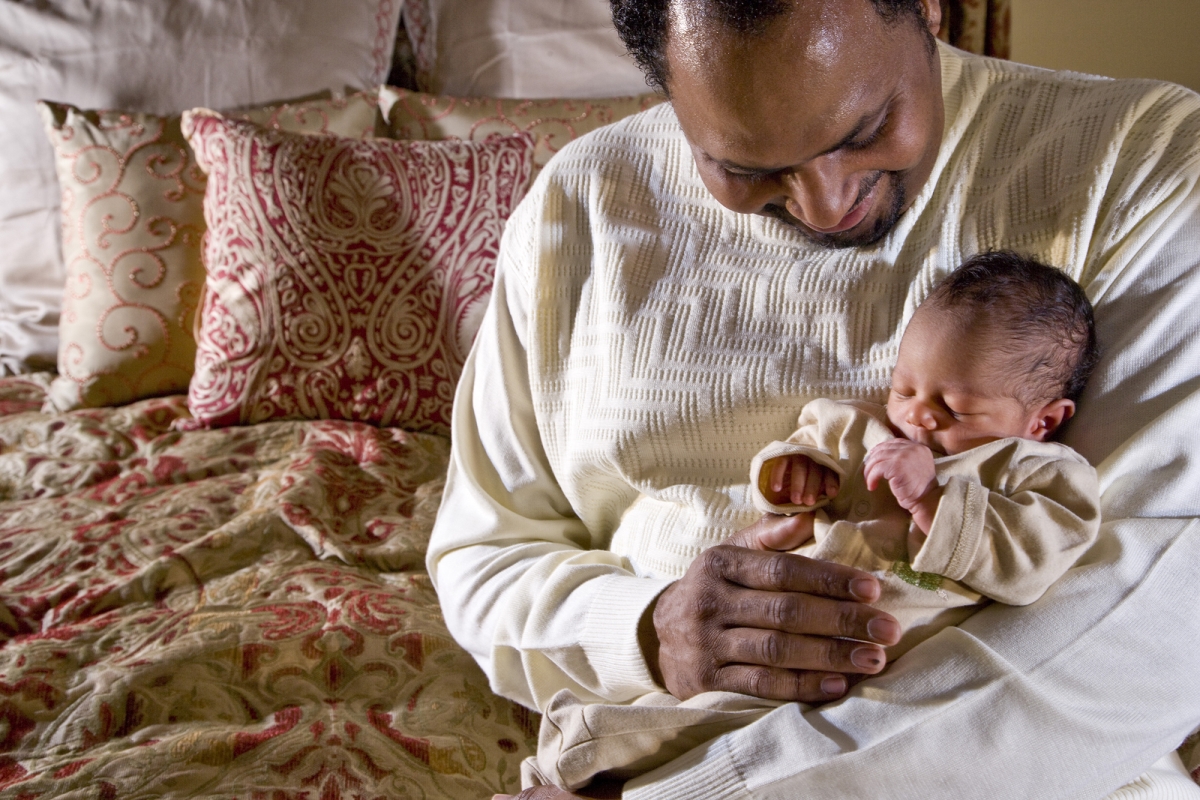Nathan Battams
Canada’s “family landscape” is constantly evolving, with social, economic, cultural and environmental forces shaping and redefining family roles and relationships. Fatherhood is no exception, and today’s increasingly diverse 8.6 million dads in Canada are now taking a much greater role in family life than in previous generations.1 Many are moving away from the “traditional” breadwinning father figure to embrace a more caring role and are assuming more household management responsibilities. In doing so, modern dads are renegotiating and reshaping the relationship between fatherhood and work.
Men are “breadwinning” less while more women are taking on more paid work
As the participation of mothers in the paid labour market increased over the past 50 years along with a rise in dual-earner families, the share of “breadwinning dads” has fallen significantly. According to Statistics Canada, in 1976, 36% of families in Canada with at least one child age 16 and under had two earners in the paid labour force. By 2014, this accounted for 69% of these families. Another Statistics Canada study found that, in the same period, the proportion of single-earner families with the father as the sole earner dropped from 51% to only 17%.
Some fathers in couple families are stepping out of the paid labour market altogether to become the lead or primary parent, more commonly known as “stay-at-home” dads, either on a temporary basis while taking care of young children or permanently. Approximately 1% of fathers in single-earner families reported being stay-at-home dads 40 years ago – a rate that has since risen to 11%.
Canada is not alone in this regard. Data from a 2015 report from Pew Research Center suggests a similar trend in the United States, with 7% of US dads with children in the household reporting in 2012 that they “do not work outside the home,” up from 4% in 1989. Among these fathers, the share who said they are staying home to care for family more than quadrupled in this period to 21% (up from 5% in 1989).
Family relationships benefit from dads increasing involvement at home
Alongside these trends, data from the General Social Survey on time use suggests that modern fathers are devoting more time to family. Men report spending more time with family, increasing from 360 minutes per day in 1986 to 379 minutes in 2010. The average number of days fathers of preschool children miss from work for personal or family responsibilities rose from 1.8 days throughout 1997 to 2.0 days in 2015. The gender gap in housework has also been found to have declined in recent generations, with men reporting spending more time on these tasks than 30 years ago.
While only 3% of recent fathers across Canada took time off to receive paid parental leave benefits in 2000, more than one-quarter (27%) reported their intention to do so in 2014. This rate is significantly higher in Quebec (78%), where paternity benefits are offered to new dads in addition to parental benefits under the Quebec Parental Insurance Plan (QPIP). Quebec is currently the only province to offer paternity benefits, although the Minister of Employment, Workforce Development and Labour recently expressed interest in setting aside time for dads by making paternity leave a part of the proposed changes to Canada’s parental benefits program.
Greater father involvement can have an impact on family life and family relationships. In a study comparing parental leave in Quebec with the rest of Canada, author Ankita Patnaik found a “large and persistent impact” on gender dynamics in the three-year period following a father’s use of paternity leave. According to her study, fathers who took leave remained more likely to do housework, while mothers were more likely to engage in paid work. Under QPIP, Quebec dads also spent an average half-hour more per day at the family home than those outside of Quebec.
With all this evolution under way across North America, it is perhaps no wonder that many people feel as though their fathers are more involved than in the past. The Pew report mentioned earlier also found that nearly half (46%) of surveyed American fathers say they personally spend more time with their children than their fathers spent with them. In Canada, a Today’s Parent poll found that three-quarters (75%) of surveyed men said that they are more involved with their children than their fathers had been with them.
Children may also be feeling the effect of greater father involvement. According to international HBSC surveys conducted by the World Health Organization in 1993–94 and 2013–14, a growing share of 11-year-old children say they “find it easy” to talk to their fathers about things that really bother them – from 56% to 66% among girls, and from 72% to 75% for boys.
Work–life balance on modern fathers’ minds
As most fathers today are still working while also taking on a greater role in the family home, work–life balance has naturally become a growing part of the discussion about modern fatherhood. Recent data from Statistics Canada shows that most fathers – nearly eight in 10 (78%) – report being satisfied with their work–life balance. Family is central to the “life” in the work–life equation: among parents who said that they were not satisfied, the main cited reason for their dissatisfaction was “not having enough time for family life.”
Through their work–life policies and practices, employers play a significant role in enhancing and supporting the work–life quality of fathers. The same Statistics Canada study found that the share of fathers who report being satisfied with their work–life balance was consistently higher among those who have a flexible schedule (81%, vs. 76% for those without), who can take advantage of a flexible work schedule without a negative impact on their career (83%, vs. 74% for those who cannot), who have the possibility of taking leave without pay to care for their children (79%, vs. 71% for those who do not), and for those who have the possibility of taking leave without pay to provide care to a spouse, partner or other family member (81%, vs. 72% for those who do not).
“The share of fathers who report being satisfied with their work–life balance is higher for those with flexible work environments and with the option to take unpaid leave to care for their children and families.”
What’s good for the family is good for the workplace
Flexibility and work–life balance satisfaction go hand in hand, which means organizations with flexible, family/father-friendly policies are more likely to attract and retain top talent who are (or plan to become) fathers. Conversely, those that do not practise flex may drive away and/or fail to attract dads – in fact, half (49%) of surveyed fathers in Canada said they would consider making a job change if a potential employer offered more family-friendly options than their current employer, according to a Harris/Decima poll.
Modern fathers aren’t caring more, they’re just providing care differently
While fathers have always cared for their families, today’s generation is becoming increasingly involved in family caring roles – a shift that brings with it benefits for family life and family relationships. While dads from previous generations provided their care through a greater emphasis on paid work and financial stability, today’s fathers are more directly involved in their children’s early years, are spending more time with family, and are seeking workplaces that support their evolving role in family life. By taking on these new roles, they are redefining what fatherhood means to families, workplaces and their communities.
Nathan Battams is responsible for publications and social media at the Vanier Institute of the Family.
Note
1 Caryn Pearson, “The Impact of Mental Health Problems on Family Members,” Health at a Glance (October 7, 2015), Statistics Canada catalogue no. 82-624-X.Link: http://bit.ly/1Lio1HL


